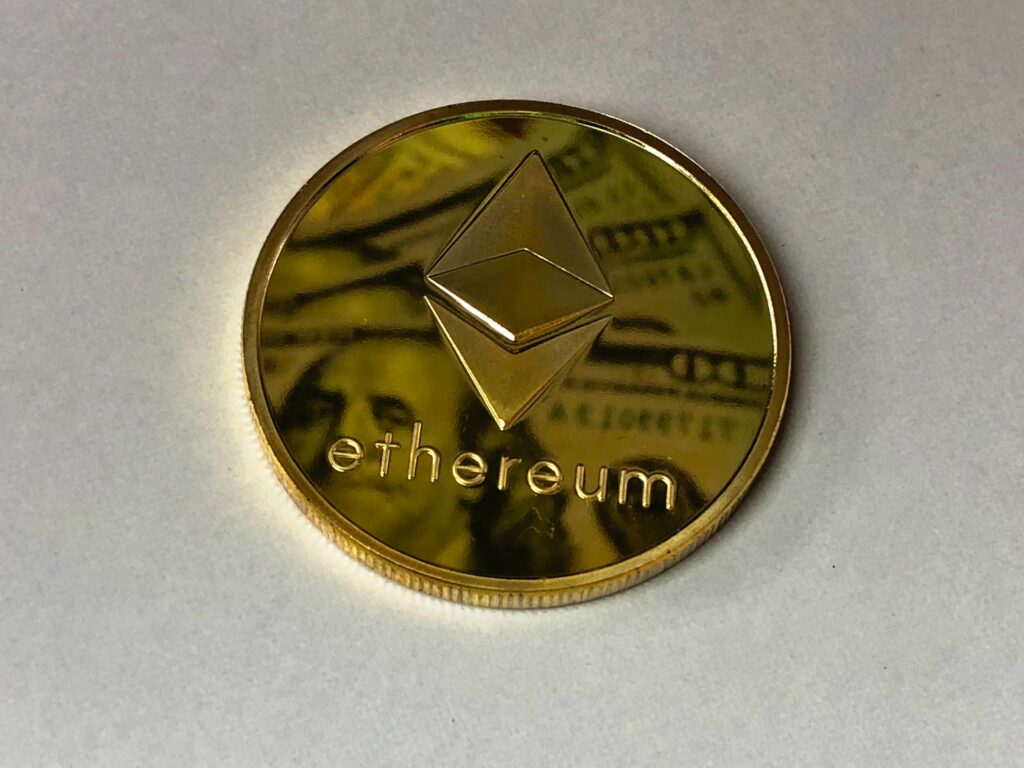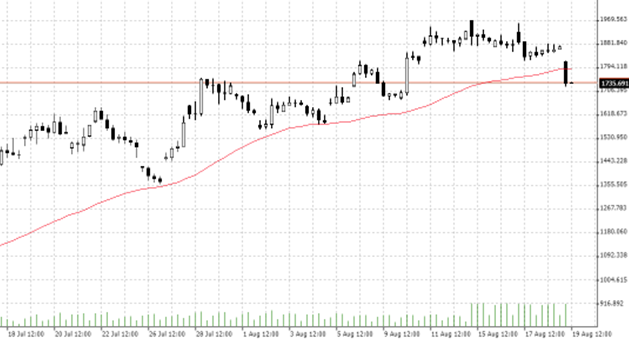

19.08.2022 – The crypto community is eagerly anticipating a major technical upgrade. Ether is to be switched from Proof of Work to Proof of Stake. Which would drastically reduce energy consumption. And would thus be more interesting for ecologically correct investors. Plus, in times of rapidly rising energy prices, more attractive for miners as well as buyers. The real hope behind all this: Ether is to replace Bitcoin as the number one cyber currency.
Because of all the newly sparked fantasies, the Ether price has risen sharply in recent weeks. However, at noon on Friday, Ether suddenly crashed and even broke through the 50 line, as you can see in the four-hour chart. To date, we have not yet found out the specific reason for this and strongly advise keeping an eye on the real-time news. This is because all cryptos collapsed across the board: Bitcoin, Litecoin, Cardano, Monero, you name it. Trading house Genesis initially blamed a drop in buying activity among long-term investors.

Source: Bernstein Bank GmbH
With that, let’s get to the background of Ether. The Ether merge event is a switch – achieved by merging (to merge, merge) the Beacon Chain with the Mainnet. On Beacon, the proof-of-stake (PoS) consensus mechanism was established. The Ethereum network’s crucial transition away from proof-of-work mining consensus (PoW) now appears nearly complete.
99 percent less energy
Roughly simplified, the issue is about streamlining the blockchain process – i.e., no more elaborate computational processes and data management. Instead, technically only the ownership of a token is to be proven. The total energy consumption of the second largest blockchain network is to fall by over 99 percent after the merge. Ethereum transactions are expected to become faster and cheaper as a result of the upgrade, commented “BTC Echo.” So these falling gas fees make investing more attractive.
A big deal: “The upcoming Ethereum Merge is the biggest narrative in crypto right now and explains why Ether has left Bitcoin in its wake in the past month,” commented Antoni Trenchev, co-founder of trading platform Nexo via email when asked by CNBC.
Things get exciting in mid-September
The Ethereum developers working on “The Merge” have also already given a concrete date for the transition to PoS, the website “Coincierge” recently reported. According to the report, Ethereum core developer Tim Beiko had mentioned September 19 as a realistic date for The Merge during a conference call. According to the U.S. television station CNBC, September 15 is the day of the switch.
Sell the News?
The possible dangers in all the euphoria: Sell the News, for one thing. Who knows if investors won’t bail out and take profits as soon as the big event is over. In addition, no one knows whether everything will really run smoothly on the technical side – the transition has already been delayed several times. Furthermore, it might be possible to tap into new customer groups who really care about the eco-factor. But outside the woken bubble, the rest of humanity might be more concerned about investigators cracking down on cyber gangsters worldwide and drying up darknet accounts that mostly hold cryptos – and such investors might prefer to look for investments that yield interest. On the other hand, cyber assets could attract new buyers, provided the issues of interest rate hikes and recession fears are through. Perhaps we really are witnessing the birth of a financial world without banks and government control.
So we’re curious to see if the tech event really does push the price higher, and we’ll keep an eye on things. Whether long or short – Bernstein Bank wishes successful trades and investments!
Important Notes on This Publication:
The content of this publication is for general information purposes only. In this context, it is neither an individual investment recommendation or advice nor an offer to purchase or sell securities or other financial products. The content in question and all the information contained therein do not in any way replace individual investor- or investment-oriented advice. No reliable forecast or indication for the future is possible with respect to any presentation or information on the present or past performance of the relevant underlying assets. All information and data presented in this publication are based on reliable sources. However, Bernstein Bank does not guarantee that the information and data contained in this publication is up-to-date, correct and complete. Securities traded on the financial markets are subject to price fluctuations. A contract for difference (CFD) is also a financial instrument with leverage effect. Against this backdrop, CFD trading involves a high risk up to the point of total loss and may not be suitable for all investors. Therefore, make sure that you have fully understood all the correlating risks. If necessary, ask for independent advice. CFDs are complex instruments and are associated with the high risk of losing money quickly because of the leverage effect. 68% of retail investor accounts lose money trading CFD with this provider. You should consider whether you understand how CFD work and whether you can afford to take the high risk of losing your money.7
